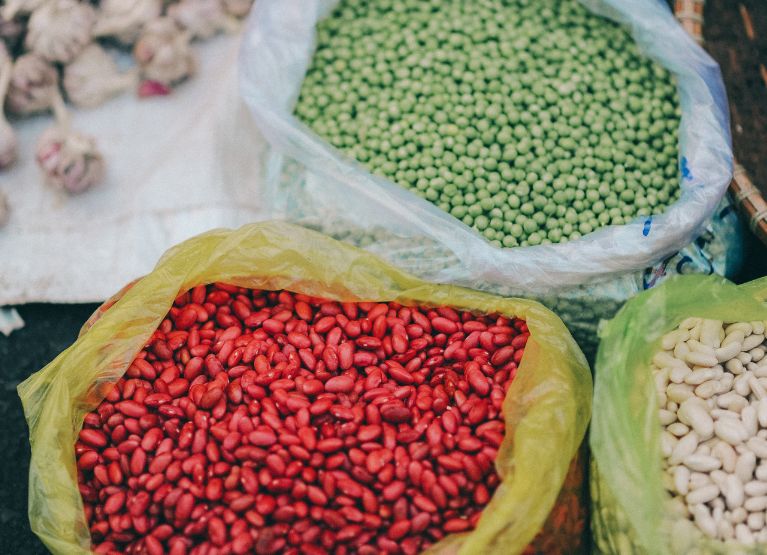You might already know about the three types of macronutrients that make up a balanced diet: carbohydrates, protein, and fat. Each of these groups has a vital function for our overall health and can be broken down even further into categories based on their nutrient levels.
Carbohydrates, the body’s primary source of energy, are made up of common foods containing starches, sugars, and fiber, each of which has a unique impact on the body. For most people, consuming good quality carbs is part of a whole food diet, as this food group can aid the digestive system, help you feel full, and may even be effective in lowering cholesterol levels.
In this article, we’ll break down the role of fiber in the diet and see what other benefits this carbohydrate can have for the body.
The Reason Fiber is Recognized as a Carbohydrate

Macronutrients are classified, in part, according to their structure. For example, protein is categorized as such because it’s made of amino acids, while fats are made up of different types of lipids. Similarly, carbohydrates are grouped together because they’re made up of sugars.
There are two types of carbohydrates that are grouped into two categories: simple and complex. Simple carbohydrates are made up of smaller units of sugar called monosaccharides and disaccharides, which cannot be broken down further by the body and are easily digestible and cause our glucose levels to rise more rapidly than other forms.
Complex carbohydrates are made up of many chains of these two types of saccharides and are found in starches and foods containing fiber. Dietary fiber is recognized as an indigestible complex carbohydrate because it is also made up of multiple saccharide chains.
Fiber comes from plant cell wall components such as cellulose and pectin, and because it’s indigestible, it’s usually subtracted from the total carbohydrate count on nutrition labels. What’s left is the net carb content, which is the amount of carbohydrates the body can digest and use for energy.
Soluble Fiber
Soluble fiber, as the name suggests, is a type of fiber that can be dissolved in water and forms a viscous, gel-like substance during digestion. This type of fiber “escapes” digestion in the small intestine and goes straight to the large intestine. Once it’s there, bacteria ferment this fiber — the fermentation process draws water in and bulks up the stool leading to healthy stool formation.
Insoluble Fiber
Insoluble fiber, like resistant starch, does not dissolve in water and is not very fermentable by the bacteria in the intestines. Instead, it acts as “roughage” and can help food move through your digestive system, promoting regularity and helping prevent constipation.
The Benefits of Eating Fiber-Rich Foods

Both soluble and insoluble fiber are key components of a healthy diet. They have numerous health benefits ranging from cardiovascular protection to preventing colorectal cancer and helping relieve constipation, and they also play an important role in helping the body digest food.
Let’s dig into a few of the most well-studied benefits of including fiber in your diet.
Eating More Fiber Will Help You Lose Weight
Increasing your fiber intake can help with weight loss in a variety of ways. Fiber has been found to increase feelings of fullness, ensuring you’re not under or overeating.
One study showed that the amount of fiber is associated with weight loss and that increasing fiber intake in your diet can promote more weight loss. Interestingly, the study found that this effect holds true regardless of how many calories or macronutrients the subjects consumed, suggesting that fiber plays a key role in healthy, sustained weight loss.
Researchers have also found that increased fiber intake creates a greater weight loss benefit in people with obesity versus those without.
Decreases Your Risk of Getting Type 2 Diabetes
Fiber helps to regulate blood glucose, or blood sugar, levels, which decreases your risk of getting type 2 diabetes.
A meta-analysis found that people consuming higher amounts of fiber had a significantly lower risk of developing type 2 diabetes than people who eat low amounts of fiber. According to the analysis, the reduction in the risk of developing type can range anywhere from 15 to 19 percent.
Along with helping to maintain healthy levels of glucose, research shows that fiber also decreases diabetes risk by improving blood lipid levels and reducing inflammation. To top it off, these effects all work together to reduce premature mortality.
Lowers Your Chances Of Getting Heart Disease
Along with reducing your risk of getting type 2 diabetes, consuming enough fiber can lower your chance of developing heart disease. It does this through different cardioprotective functions such as:
- Lowering blood pressure
- Improving blood lipid levels
- Improving clotting
- Improving glycemic response
Some research has shown that soluble fiber reduces risk factors of cardiovascular heart disease whereas insoluble fiber reduces the incidence of heart disease.
Promotes Healthier Gut Bacteria
Fiber, especially the soluble kind, is “eaten up” in the gut and can promote healthier gut bacteria or microflora. Having a healthy and diverse microflora improves gut barrier function and reduces inflammation ultimately boosting metabolic health. One study found that people who ate more fiber not only had a more diverse species of bacteria but were also observed to have higher levels of beneficial bacteria.
Most versions of the Western diet include low amounts of fiber. Researchers show that people living in these regions and following this type of diet have lower amounts of beneficial bacteria as a result.
Reduces Your Odds of Getting Certain Cancers
Consuming adequate amounts of fiber can also reduce your risk of getting certain cancers. It’s been well studied that fiber can protect against colorectal cancer. Research shows that a low fiber diet may actually increase the risk of colorectal cancer while a high fiber diet protects against it.
High fiber diets may also protect against gastrointestinal, breast, ovarian, and endometrial cancers. This cancer-reducing benefit is gained through eating a healthy, whole foods diet with lots of fiber as opposed to just taking a fiber supplement.
Fiber and Blood Sugar: How Does Eating Fiber Affect Blood Sugar Levels

By now, you know all about the various health benefits that a high fiber diet has to offer, but you may be wondering how this can impact your blood sugar levels. Both soluble and insoluble fiber work together to improve glycemic control in the body.
Soluble fiber, which is found in things like oats, apples, and peas, reduces how much glucose levels increase after a meal (also called postprandial glucose response). This prevents large blood sugar spikes and subsequent crashes and can help you maintain a steady level of energy throughout your day.
Insoluble fiber in foods like berries, nuts, and cauliflower, supports insulin sensitivity. With improved insulin sensitivity, it’s easier for the cells in your body to let the glucose in, leading to more stable and improved levels of blood sugar.
How Much Fiber Should You Consume Each Day?
If you’re ready to reap the benefits of fiber, here’s the healthy recommended serving to aim for according to the Mayo Clinic:
- For females, aim to consume 21 to 26 grams of fiber a day.
- For males, aim to consume 30 to 31 grams of fiber a day.
Please keep in mind that these are not a one-size-fits-all range to work towards, and recommendations may vary across organizations. However, the American Diabetes Association advises that most people consume at least 14 grams of fiber per 1,000 calories.
Some individuals may need more or less, so working with a credentialed dietitian or nutritionist can help you figure out your optimal fiber intake. It’s important to note that increasing fiber gradually can help your body become accustomed to the change without causing digestive problems such as bloating and gas.
High Fiber Foods to Add to Your Diet
Fiber is most often found in things like fruits, vegetables, whole grains, and legumes. Here are some tasty and blood sugar-balancing foods you can add to your diet to increase your fiber intake.
Whole Fruits

Because fruits come from plants, they are a great source of fiber. Pears contain 6 grams of fiber per serving and are high in antioxidants.
Raspberries, like pears, are another great source of fiber, with 100 grams of raspberries providing six and a half grams of fiber and are also high in vitamin C, iron, magnesium, and calcium.
Avocados are another fruit that is low in sugar and rich in fiber. One-half of an avocado provides a little over four grams of fiber and contains satiating healthy fats which add to its blood sugar balancing properties.
A serving of 100 grams of raw strawberries contains two grams of fiber and 59 milligrams of vitamin C, which plays an important role in collagen synthesis, immune function, and wound healing. Fruits can be high in carbohydrates, so be sure to choose fruits with a lower glycemic index and pair them with protein to balance blood sugar.
Non-starchy Vegetables

Vegetables are another one of the most common sources of dietary fiber. One great example is okra, which contains about 8 grams of fiber per 100 grams and is a good source of potassium and calcium.
Additionally, the phytochemicals in okra have beneficial effects on type 2 diabetes and cardiovascular disease. One 100-gram serving of artichokes contains a little over five grams of fiber and is loaded with vitamins, C, K, B9, and magnesium.
Pulses and Legumes

Pulses and legumes such as lentils, beans, and peas are great sources of fiber, offering about 7 to 8 grams each per 100 grams. Although these foods are full of fiber, they are also dense carbohydrate sources, it’s important to opt for a moderate portion size, pair them with veggies, and protein for an optimal blood sugar response.
These foods contain both soluble and insoluble fiber, and also can support cardiovascular health, prevent certain types of cancer, and are a great option for people with diabetes due to their low glycemic index.
Whole Grains

Whole grains such as brown rice, quinoa, whole-wheat cereals, and wheat bran are also high in both soluble and insoluble fiber and can lower your risk of diabetes, obesity, and heart conditions.
Grains are also a dense source of carbohydrates and can impact glucose levels, so aim to consume a moderate portion size, figure out which grains you do best with using a CGM, and balance your plate with protein and non-starchy vegetables.

